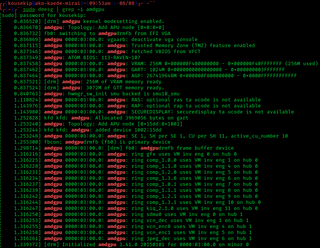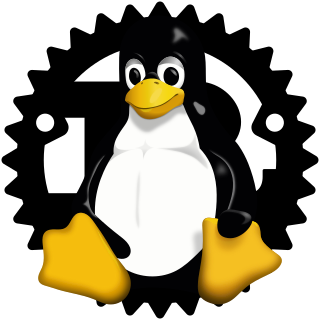ReiserFS is a general-purpose, journaling file system initially designed and implemented by a team at Namesys led by Hans Reiser and licensed under GPLv2. Introduced in version 2.4.1 of the Linux kernel, it was the first journaling file system to be included in the standard kernel. ReiserFS was the default file system in Novell's SUSE Linux Enterprise until Novell decided to move to ext3 for future releases on October 12, 2006.

A kernel panic is a safety measure taken by an operating system's kernel upon detecting an internal fatal error in which either it is unable to safely recover or continuing to run the system would have a higher risk of major data loss. The term is largely specific to Unix and Unix-like systems. The equivalent on Microsoft Windows operating systems is a stop error, often called a "blue screen of death".
Reiser4 is a computer file system, successor to the ReiserFS file system, developed from scratch by Namesys and sponsored by DARPA as well as Linspire. Reiser4 was named after its former lead developer Hans Reiser. As of 2021, the Reiser4 patch set is still being maintained, but according to Phoronix, it is unlikely to be merged into mainline Linux without corporate backing.
The Linux kernel mailing list (LKML) is the main electronic mailing list for Linux kernel development, where the majority of the announcements, discussions, debates, and flame wars over the kernel take place. Many other mailing lists exist to discuss the different subsystems and ports of the Linux kernel, but LKML is the principal communication channel among Linux kernel developers. It is a very high-volume list, usually receiving about 1,000 messages each day, most of which are kernel code patches.

The Linux kernel provides multiple interfaces to user-space and kernel-mode code that are used for varying purposes and that have varying properties by design. There are two types of application programming interface (API) in the Linux kernel:
- the "kernel–user space" API; and
- the "kernel internal" API.

A free and open-source graphics device driver is a software stack which controls computer-graphics hardware and supports graphics-rendering application programming interfaces (APIs) and is released under a free and open-source software license. Graphics device drivers are written for specific hardware to work within a specific operating system kernel and to support a range of APIs used by applications to access the graphics hardware. They may also control output to the display if the display driver is part of the graphics hardware. Most free and open-source graphics device drivers are developed by the Mesa project. The driver is made up of a compiler, a rendering API, and software which manages access to the graphics hardware.

nouveau is a free and open-source graphics device driver for Nvidia video cards and the Tegra family of SoCs written by independent software engineers, with minor help from Nvidia employees.
kernel.org is the main distribution point of source code for the Linux kernel, which is the base of the Linux operating system.

The blue screen of death is a critical error screen displayed by the Microsoft Windows operating systems. It indicates a system crash, in which the operating system reaches a critical condition where it can no longer operate safely.

The Linux kernel is a free and open source, UNIX-like kernel that is used in many computer systems worldwide. The kernel was created by Linus Torvalds in 1991 and was soon adopted as the kernel for the GNU operating system (OS) which was created to be a free replacement for Unix. Since the late 1990s, it has been included in many operating system distributions, many of which are called Linux. One such Linux kernel operating system is Android which is used in many mobile and embedded devices.

Mode setting is a software operation that activates a display mode for a computer's display controller by using VESA BIOS Extensions or UEFI Graphics extensions.
Simple Firmware Interface (SFI) is developed by Intel Corporation as a lightweight method for firmware to export static tables to the operating system. It is supported by Intel's hand-held Moorestown platform.

The Linux console is a system console internal to the Linux kernel. A system console is the device which receives all kernel messages and warnings and which allows logins in single user mode. The Linux console provides a way for the kernel and other processes to send text output to the user, and to receive text input from the user. The user typically enters text with a computer keyboard and reads the output text on a computer monitor. The Linux kernel supports virtual consoles – consoles that are logically separate, but which access the same physical keyboard and display. The Linux console are implemented by the VT subsystem of the Linux kernel, and do not rely on any user space software. This is in contrast to a terminal emulator, which is a user space process that emulates a terminal, and is typically used in a graphical display environment.
Namespaces are a feature of the Linux kernel that partition kernel resources such that one set of processes sees one set of resources, while another set of processes sees a different set of resources. The feature works by having the same namespace for a set of resources and processes, but those namespaces refer to distinct resources. Resources may exist in multiple namespaces. Examples of such resources are process IDs, host-names, user IDs, file names, some names associated with network access, and Inter-process communication.

AMDgpu is an open source device driver for the Linux operating system developed by AMD to support its Radeon lineup of graphics cards (GPUs). It was announced in 2014 as the successor to the previous radeon device driver as part of AMD's new "unified" driver strategy, and was released on April 20, 2015.
RPMsg is a protocol enabling inter-processor communication inside multi-core processors.

Kernel page-table isolation is a Linux kernel feature that mitigates the Meltdown security vulnerability and improves kernel hardening against attempts to bypass kernel address space layout randomization (KASLR). It works by better isolating user space and kernel space memory. KPTI was merged into Linux kernel version 4.15, and backported to Linux kernels 4.14.11, 4.9.75, and 4.4.110. Windows and macOS released similar updates. KPTI does not address the related Spectre vulnerability.
Bcachefs is a copy-on-write (COW) file system for Linux-based operating systems. Its primary developer, Kent Overstreet, first announced it in 2015, and it was added to the Linux kernel beginning with 6.7. It is intended to compete with the modern features of ZFS or Btrfs, and the speed and performance of ext4 or XFS.
This article documents the version history of the Linux kernel.

Rust for Linux is an ongoing project started in 2020 to add Rust as a programming language that can be used within the Linux kernel software, which has been written using C and assembly only. This project aims to leverage Rust's memory safety to reduce bugs when writing kernel drivers. Progress has been slower than hoped by both Rust advocates and Linus Torvalds, lead of the Linux kernel project. In December 2023 the first drivers written in Rust were accepted, and released in version 6.8.











